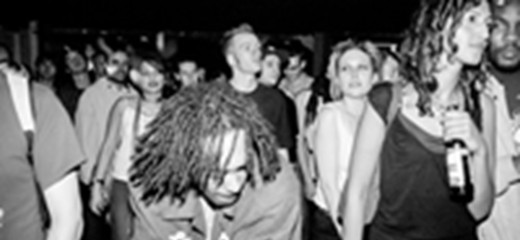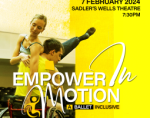
Dance Your Way Home
by Catja Christensen
What does it mean to dance your way home? I imagine Gene Kelly singing and tapping in the rain, so full of giddy romance and starry-eyed as the night sky that simply walking home isn’t enough. Outside of Hollywood and off the stage, Londoner and journalist Emma Warren imagines that dancing home is as natural and essential as breathing. Not formally trained in dance, Warren is a professional author and journalist with lifelong dance experience. In her youth, she ventured into dance halls and clubs around London and extended her informal dance education worldwide, from South Africa to the United States.
In her latest book, Dance Your Way Home: A Journey Through the Dancefloor, written during the 2020 pandemic, she reflects on the power of collective artistic and physical expression across all walks of life. Warren blends personal anecdotes of evocative embodied experiences with a serious and occasionally cheeky tone. She shares intimate interviews with influential, interdisciplinary artists, and detailed histories about dance floors and sound systems. Ultimately, the book emphasizes that everyone can and should dance.
On her book release Instagram announcement, Warren writes that the idea for Dance Your Way Home “came from a couple of lines in Make Some Space [her previous book] that a few people honed in on – that dancing in the dark is a human need, that we’ve been doing this forever, and that it’s a kind of medicine.” Dance Your Way Home is a labor of love, spanning three years, shelves of dance books, and hours of research. She blends her club-dancing fieldwork with historical research. The respect given to social dance and music is evident and undistinguished from how we are used to reading about concert dance or popular music. The constant pulse of her work is that dance is everywhere, and it is nothing to be afraid or ashamed of. “I’m not a dancer” is not a recognized phrase in Warren’s world.
Fear of judgment is innate in most humans, and Warren addresses this powerful detriment to enjoying dancing’s full potential by expressing her vulnerabilities. She acknowledges that dancing with others can often feel embarrassing, vulnerable, and terrifying, especially in British culture. The book opens with an anecdote about overcoming this initial sense of shame and shyness. She recalls a trip to Soweto, South Africa. Her years of dancing in London clubs and her desire to move as herself conflicted with the self-consciousness and self-judgment of her own dancing compared to others in Soweto. On the flight home, she promised herself that if she ever went back, she would “bring all the dance [she] had” and her “honest self.” She did return 18 months later, releasing the insecurities about her dancing in a bar in Cape Town and daring to dance as herself. This brave admission earned my trust, and I began to let my own insecurities and hesitancies as a dancer come to mind. I let Warren guide me through why these emotions exist and how to gently release them rather than judge myself for experiencing them in the first place.
She practices what she writes: dancing together and sharing in community can provide stability and support, offering an outlet for expressing that which words cannot convey. Her book is not just full of individual and collective histories. It also offers permission to open yourself to entering the intimidating spaces of clubs and community centers and experience firsthand what she documents.
Warren’s anecdotes of dance experiences and quotes from fellow movers, musicians, and artists are the most compelling threads tying the book together. In the first chapter, she writes about a phone call with Toni Basil, a dance historian and artist known for her version of the earworm song, “Mickey.” Basil recalls a conversation with Henry Link of hip-hop dance crew M.O.P.T.O.P.: “I said to him, ‘Oh my god, I wish I could improvise like you. I wish I could dance like you.’ He looked at me and said, ‘Dance your history,’ and it was one of the best things anyone has ever said to me.”
In the penultimate chapter of the book, Warren cites the sleeve notes to Gabrielle Roth’s meditation soundtrack Endless Wave, in which Roth recalls dreaming that she met legendary flamenco dancer, La Chunga. In the dream, Roth tells her “I want to dance like you,” and La Chunga replies, “Then dance like you, fool!” Warren then references Basil’s real-life exchange from 300 pages earlier, comparing La Chunga’s brutal yet amusing version of the mantra with Basil and Link’s more solemn oath to preserve history. These quotes are the driving force behind Warren’s extensive embodied and historical research into social and personal dance.
The book paints an intricate picture of clubs all around Europe and parts of the United States. From pulsating clubs in Shoreditch in London to lively dance floors in South Side Chicago, musicians and dancers of all ages and identities are integral to keeping the clubs alive and evolving. She insists on naming and crediting every influential artist or group, resulting in a vast web of artists and movers all connected through the human need to dance. Dance Your Way Home is not a book you breeze through; it is a comforting tome that you read a chapter at a time, absorbing the web of artistry and history with a mug of tea and a highlighter, or hundreds of annotation tabs as I did.
This is a book for people, for anyone who finds themselves swaying or tapping their foot to a catchy song, who seeks an outlet for expressing the internal complexities of human emotions, and who dances in their bedrooms, studios, or stages. It is for, as Warren writes, “a babe in arms being rhythmically soothed to sleep as a tired person performs a slow waltz around a dark bedroom, dancing to the invisible music of new parenthood… to the low-frequency quartet of heartbeat, blood flow, digestive rumble, and maternal voice.”
Dance like you, dance your history, and dance your way home.
Emma Warren, Dance Your Way Home: A Journey Through the Dancefloor, Faber & Faber Ltd, 2023.
By Catja Christensen
January 27, 2024








